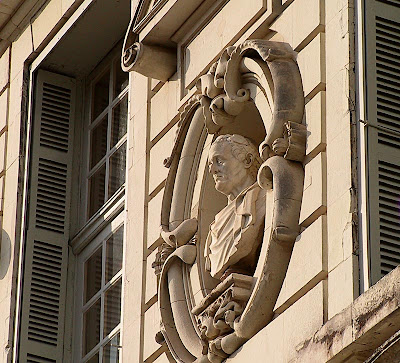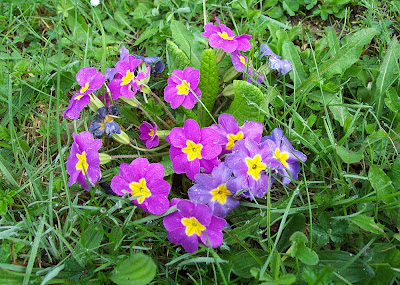Yesterday Walt and I talked about the things we miss from all the years we were "America-based," and we talked about the subject with two other ex-pat friends we happened to see yesterday for the first time in a month or so.
We decided the bigger difference between America and France for us is the difference between living in the country vs. living in the city. We miss the convenience of having almost everything available and close at hand. I mean shopping. But we don't miss the noise and traffic and high cost of living.
The primroses of springtime in our yard —
they come up spontaneously every year
Walt said he misses being able to find good quality clothes and shoes for reasonable prices. It's true that clothes out here in the French countryside are hard to buy and usually expensive. I buy most of my clothes in North Carolina when I go back there for my annual visit. Since we don't work now, our clothing needs are much reduced compared to the days when we worked in California.
Sometimes I miss the ocean and the salt air. It's because I grew up on the coast. I remember the first time I went to San Francisco, the thing that attracted me the most — even more than the mild weather, beautiful hills, and old-fashioned feel of the place — was the smell of the sea I got there. It reminded me of home in North Carolina.
Early spring days in the vineyard
When I miss the ocean now, it's N.C. that I miss, not California. Luckily, France has a very long coastline and we've been able to enjoy trips to the Normandy coast and the Atlantic island of Oléron (which really made me feel at home so much it resembled the low, sandy N.C. coast).
I miss being able to get a good, juicy American hamburger. Even making them at home isn't completely satisfactory, because the meat — grass-fed rather than grain-fed beef — is just different. In general, I prefer the grass-fed beef. I also miss Eastern North Carolina barbecued, pulled pork, but I can make that here with satisfactory results.
I miss Asian food as we knew it in California, but that's one of those city vs. country things. If we were in Paris, we'd have Asian food the way we did in San Francisco. (By the way, our lunch today will be Szechuan Eggplant with Ground Turkey, home-made.)
It's nice to get the plants back outside in spring.
My jade plant had a good winter indoors.
I never felt happy living in California the way I feel happy about living in France — even though we spent nearly 20 years in California. Maybe if I had been able to spend more time in San Francisco the way I spent time in Paris — as a pedestrian rather than a commuter stuck in traffic — I would have liked it better. I miss California friends, but many of them have come to visit us in France over the past 9 years.
Sunrise with clouds a couple of days ago
When I felt homesick in California, it was mostly for France (my "cultural" home), and partly for North Carolina (my "biological" home). The other two places where I've lived — Champaign-Urbana, Illinois, and Washington DC — are completely tied up with France, because at the first I was a student and teacher in the university French department, and in the second I was a translator and writer working in French (with CHM).
Another plant that spent the winter in the house and
is happy to be out in the fresh air again
I can't say that I've felt homesick at all since we moved to Saint-Aignan. However, I really enjoy my trips back to the U.S., especially to my home town in N.C., and I'm happy that I might have two American trips in 2012. More about those as the times approach.





















































